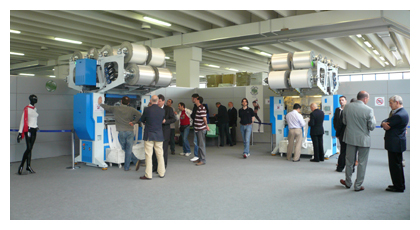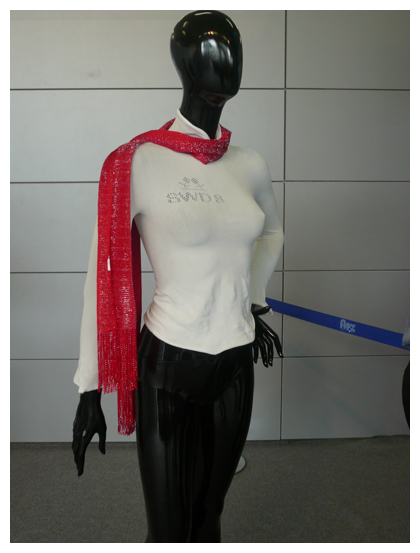
The continuing evolution of Santoni Seamless technology
In Part 1 of a Two Part Feature, Billy Hunter examines Santoni's latest quest for Seamless success. Santoni SpA, leader in circular knitting machines for seamless garments has surprised the knitting and hosiery industries with a venture into double needle bar warp knitting. Some visitors to the company’s Santoni Days exhibition last week, who came to look at the latest hosiery and seamless developments from the likes of Lonati, Santoni, Sangiacomo and Matec however, see

8th June 2008
Knitting Industry
|
Brescia
In Part 1 of a Two Part Feature, Billy Hunter examines Santoni's latest quest for Seamless success.
Santoni SpA, leader in circular knitting machines for seamless garments has surprised the knitting and hosiery industries with a venture into double needle bar warp knitting. Some visitors to the company’s Santoni Days exhibition last week, who came to look at the latest hosiery and seamless developments from the likes of Lonati, Santoni, Sangiacomo and Matec however, seemed just a little bemused.
Most Lonati Group companies like Santoni come out of a hosiery machinery background and some of the others from a circular knitting machinery background. For Santoni to show warp knitting machines then, was a surprise to say the least. The move could however prove to be a good piece of lateral thinking on the part of the Lonati Group. With the circular Seamless boom over and a corresponding slowdown in sales, Santoni would welcome the opportunity to develop new markets.
 Santoni showed two prototype SDW8 double needle-bar raschel knitting machines for producing seamless garments. The SDW8 is a double needle bar raschel knitting machine equipped with eight guide bars with a working width of 44 inches (1118mm). Two versions of the machine were shown in 24 gauge (needles per inch), each of which was knitting two seamless garments side by side in chain formation, with garment blanks to be separated later by cutting. A women’s long sleeved top was being produced which required some cutting but no sewing except for the addition of trims if desired.
Santoni showed two prototype SDW8 double needle-bar raschel knitting machines for producing seamless garments. The SDW8 is a double needle bar raschel knitting machine equipped with eight guide bars with a working width of 44 inches (1118mm). Two versions of the machine were shown in 24 gauge (needles per inch), each of which was knitting two seamless garments side by side in chain formation, with garment blanks to be separated later by cutting. A women’s long sleeved top was being produced which required some cutting but no sewing except for the addition of trims if desired.
The more complex version of the SDW8, which was knitting women’s patterned long sleeved tops, was equipped with electronic patterning by means of piezo elements giving the machine almost unlimited patterning scope. Guide bar movement is also electronically controlled via linear motors. Both machines were fitted with 21 inch warp beams which are controlled at each beam position by electronic let-off devices.
A second version of the SDW8 was knitting two pairs of pantyhose side by side which later required cutting and some sewing. Apart from the patterning device, the machine was of similar specification to the machine with unlimited patterning capability.
 SDW8 garments are knitted as follows. Each SDW8 machine is fitted with two opposing needle bars equipped with compound needles which are fed yarns by moving guide bars. Warp yarns are selected via the electronic selection system and piezo elements, and presented to those needles which are to be knitted.
SDW8 garments are knitted as follows. Each SDW8 machine is fitted with two opposing needle bars equipped with compound needles which are fed yarns by moving guide bars. Warp yarns are selected via the electronic selection system and piezo elements, and presented to those needles which are to be knitted.
For a seamless garment, knitting commences with the knitting of three tubes side by side (sleeve/ body/ sleeve), which are created by knitting on both needle bars and by closing each tube at the edges by knitting. Knitting then continues to the underarm position at which point knitting proceeds in a single tubular fashion up to the neck opening. However, the shoulder shape of the garment is created by joining of the knitting of both needle bars in a predefined pattern within the tube.
When the neck opening has been reached, the cycle starts over again to commence knitting of the next garment. To convert the lengths of body blanks into garments, the waste sections are removed by cutting and the shoulder line which was created by joining the knitting of both needle bars, acts as a seam. Each garment blank is separated from the other by a simple horizontal cut.
 Double needle bar raschel machines have been around for decades, as has development of seamless garments on the technology. Both Karl Mayer and Liba, leading German builders of warp knitting machinery, manufacture double needle bar machines which are used for many purposes including spacer fabrics for technical applications such as foam replacement in the automotive and transport industries.
Double needle bar raschel machines have been around for decades, as has development of seamless garments on the technology. Both Karl Mayer and Liba, leading German builders of warp knitting machinery, manufacture double needle bar machines which are used for many purposes including spacer fabrics for technical applications such as foam replacement in the automotive and transport industries.
Karl Mayer, together with a handful of warp knitters has, however, pioneered seamless warp knitted garments for lingerie and hosiery in recent years and has announced just a few weeks ago that its Nippon Mayer subsidiary will be launching its latest double needle bar machine, the DJ 4/2 in September this year (read our report).
Nippon Mayer has sold a relatively small number of machines around the world which are producing seamless garments, most of which have wide working width up to 130 inches, which is a fairly standard working width for a warp knitting machine. With a keen eye on the seamless garment market, the new DJ 4/2 will be available in a narrow working width of 42 inches. Santoni’s SDW8 has a working width of 44 inches.
Lonati Group spokesperson Franco Sciacca told Knitting Industry: “We see the SDW8 development as an extension of our Seamless garment philosophy. Santoni is now known as the world leader in Seamless and we want to explore different technologies so that we can widen the reach of Seamless.”
Santoni claims it has filed fifteen patents around its SDW8 technology and says that although the technology it is using is not revolutionary, the combination of technologies and the way they are used is. Franco Sciacca explained: “The combination of the linear motor guide bar control, electronic patterning by piezo elements and relative movement of the needle bars to other elements is the secret to this machine.”
Santoni showed a range of garments which could be knitted on the SDW8 but was keen to emphasise that the garments had not been produced on the SDW8 but they had been purchased from retail in order to show what might be possible on the machine.
As the SDW8 is a prototype machine, it is highly unlikely that the machine was running at its optimum speed. The company was reluctant to quote either speeds or knitting times but Knitting Industry timed a garment length (two garments side by side) coming off the machine in about eight minutes, equivalent to a knitting time of about four minutes per garment. Many Santoni circular knitted Seamless garments are of course knitted in much shorter knitting times but require sleeves to be attached by sewing. The SDW8 has the sleeves knitted integrally, reducing both knitting times and yarn wastage.
Read Part 2 of this feature soon on Knitting Industry.

Business intelligence for the fibre, textiles and apparel industries: technologies, innovations, markets, investments, trade policy, sourcing, strategy...
Find out more